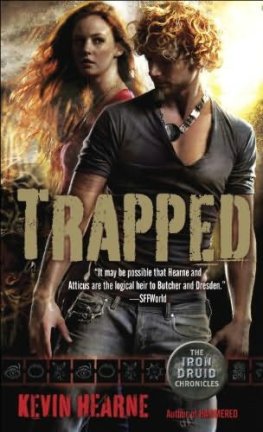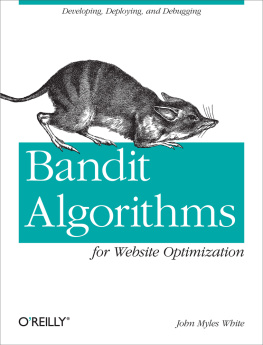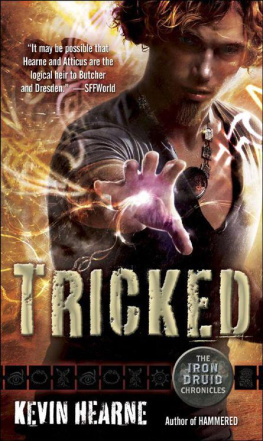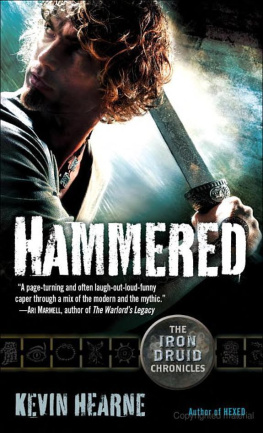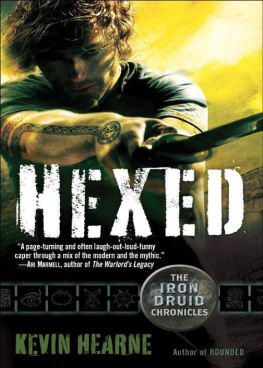ALSO BY VICKI HEARNE
Adams Task: Calling Animals by Name
Animal Happiness
In the Absence of Horses
Nervous Horses
The Parts of Life
The White German Shepherd
Bandit
The Heart-Warming True Story of One Dog's Rescue from Death Row
Vicki Hearne
Copyright 2007 by Vicki Hearne
Introduction copyright 2007 Elizabeth Marshall Thomas
Postscript copyright 2002 Donald McCaig
All Rights Reserved. No part of this book may be reproduced in any manner
without the express written consent of the publisher, except in the case
of brief excerpts in critical reviews or articles. All inquiries should be
addressed to: Skyhorse Publishing, 555 Eighth Avenue, Suite 903, New
York, NY 10018.
www.skyhorsepublishing.com
10 9 8 7 6 5 4 3 2 1
Library of Congress Cataloging-in-Publication Data
Hearne, Vicki, 19462001
Bandit : the heart-warming true story of one dogs rescue from death row
/Vicki Hearne ; With a new Introduction by Elizabeth Marshall Thomas.
p. cm.
Includes bibliographical references and index.
9781602390706
1. Pit bull terriersUnited States. 2. Pit bull terriersLaw and
legislationUnited States. 3. Pit bull terriersConnecticutAnecdotes.
4. DogsSocial aspectsUnited States. I. Title.
SF429.P58H43 2007
363.78dc22
2007010873
Printed in Canada
The world was conquered through the understanding of dogs; the world exists through the understanding of dogs.
Nietzsche
My lord, my liege lord, my dear lord, what I desire is my own and not your kindness.
A poor man is better than a liar, dear my lord, suppose the desire of a man is his kindness.
Donald Davie
Introduction
V icki Hearne, who died much too soon at the age of fifty-four, was a teacher, a poet, and an animal trainer. Her first book, Adams Task, is a poem-like whirlwind of philosophy, linguistics, stories, legal and literary theory, scholarship, opinion, anger, love, poetry, and the first-rate animal observation that became her trademark. Bandit, published five years later, became its worthy successor.
On the surface, Bandit is the story of a dog by that name, sentenced to death for biting but rescued through the good offices of Hearne, who hired an attorney and testified in court on his behalf. Bandit was allowed to live, but on the condition that Hearne adopt and train him. She did. Bandit taught Hearne fully as much as Hearne taught Bandit, and their mutual experience in its human and historical settings is the theme of the book.
Thus, it is no simple dog story. Instead, it illuminates the complex role of dogs in our society and our complex ways of thinking about and dealing with them. Bandit was known as a pit bullthat dreaded breed damned as vicious and outlawed almost everywhereyet it would seem that there is no such thing as a pit bull, which is merely a convenient misnomer for many different breeds. Nor is it true that such dogs are naturally vicious. Bandit bit a woman because she was physically assaulting someone whom Bandit knew. The authorities forgave the dog on the condition that the owner fence his yard, but Bandit was afraid of the fence, and took to relieving himself on his owners porch. For this, the owner beat him severely. During one beating, Bandit bit his owner. In short, Bandit bit defensively and understandably, and, at least in the case of his first bite, laudably. Many other dogs would do the same. There is nothing inherent in this kind of biting, but try telling that to animal control authoritiesthe most dangerous enemies of pit bulls. When Bandit appeared before the judge as a two-time biter, the authorities cried out for vengeance: Bandit deserved execution. It took Hearnes intelligence, dedication, and money to save him, but save him she did, over much public outcry and many objections. To this day, sixteen years after the publication of Bandit, a few detractors still fulminate about Bandits salvation. One detractor, fluent in four-letter words, posts his venom on the Internet, calling Hearne mentally disturbed, and, due to inadequate scholarship, also calls her he and him.
And yes, Hearne does rub some people the wrong way. She aims her critical barbs at all kinds of ideas and institutions, including the American Kennel Club, also PETA (People for the Ethical Treatment of Animals) and most humane societies. These institutions, as she points out, would rescue stray animals only to kill them later. Better to be a stray. She ardently dislikes the Humane Society of the United States, which, she claims, has urged that any dog used primarily to guard public or private property be seized and destroyed without a hearing. Sooner or later, every readers feathers will be ruffled by something she says. But all who share her intense feelings for animals in general and dogs in particular will forgive her completely: She speaks for those who cant speak for themselves, and she does it brilliantly.
The book has much to teach. Dog trainers should read Bandit, if only to learn what those who train other kinds of animals already knowthe process is not about domination. A tiger trainer, for example, cannot dominate a tiger, and so he must, with soothing words and little bites of meat, create an atmosphere of mutual respect. Hearne knows this better than anyone. Her discussions of animals radiate with the respect that she feels for them. Although many people treat their pet animals as if they were slaves to be mastered or infants to be coddled, Hearne treats animals as respected colleagues, adults with histories that they remember and important, separate lives of their own. In other words, she values them for who they are, not for a persona that she superimposes. She says of bull terriers that she likes their spirit, their lan vital, their refusal to respond to any but honest, straightforward training methods, their courage. Their hearts, above all their deep hearts.
Those who fear pit bulls should also read Bandit. Hearne presents a torrent of information on dogs falsely accused, on statistics skewed or just plain misrepresented, and on anti-dog propaganda generated by the media. Bandit, for instance, had protected his old neighborhood. Yes, he bit an unruly woman, but, like his human neighbors, he favored an orderly environment. Neighborhood crime increased after his removal, including a ghastly, unexplained murder, which according to the neighbors, Bandits presence could have prevented. Yet the Canine Control authorities deemed him vicious and condemned him. As for viciousness, Hearne writes: The difference between difficult dogs and vicious human beings is that difficult dogs do not rise to positions of prominence in the community. She quotes his owner: Theres more man and more backbone to that dog than to any of these folks who want to kill him.
Since this book appeared, many people have taken an interest in the plight of pit bulls. Valerie Humes made a documentary film, A Little Vicious , about them in general and Bandit in particular. And at least for a while, the anti-bull-terrier crowd became subdued. Some books about dogs could be called the Lassie genre, about unusual, almost supernatural dogs. But the best books about dogs are about real dogs. These dogs are everywhere. What makes any one of them seem unusual is that someone like Hearne has singled him out, got to know and understand him, and shone a spotlight on him for the reader. In Bandit, Hearne has interpreted a so-called dangerous dog, and its now up to us to apply what we have learned.
ELIZABETH MARSHALL THOMAS
Acknowledgments
T HERE IS, oh, there is Plato, of course, because he records Socrates remarks on the learning that constitutes a protective and stalwart hounds work, even though I feel sometimes that there is something inelegant about being grateful to Plato. There is also, momentously, Mark Twain, for making fun of the dogfighters yarn.



